మనసులో అనుభూతులను నలుగురితో పంచుకోవాలి అన్న ఆకాంక్షకు రూపం ఈ నా ప్రయత్నం.నాకు మన దేశం గురించి,మన సంప్రదాయాలు,అలవాట్లు, ఆచారాలూ,పద్దతులు మరియు మనం ప్రపంచం మొత్తానికి ఇచ్చిన ఆధ్యాత్మిక జ్ఞానం అన్న,దాని గురించి తెలుసుకోవడం అన్న,చెప్పడం అన్న చాలా ఇష్టం.అందుకే నా అంతరంగాన్ని,భావాలను,నాకు తెలిసిన,నేను సేకరించిన సమాచారాన్ని ఒక దగ్గర చేర్చాలనే ఈ బ్లాగ్ స్టార్ట్ చెయ్యడం జరిగింది.నేను ఎక్కడైనా చదివిన,చూసిన,నాకు తెలిసిన మంచి సమాచారాన్ని ఇందులోపొందుపరచి అందరికి ఒక బ్లాగ్ లో ఇవ్వాలని ఆసిస్తూ మీ శ్రేయోభిలాషి
29, జూన్ 2009, సోమవారం
భగవాన్ ! ప్రపంచం క్లిష్ట సమయంలో ఉంది. దీనికి పరిష్కారం సూచించండి
కంచి శంకరాచార్య శ్రీ చంద్రశేఖరేంద్ర స్వామిని సేవించి తనకు జ్ఞానమార్గం చూపమని అర్థించాడు. ఆయనే పాల్ బ్రంటన్ ను రమణ మహర్షివద్దకు వెళ్లమని సలహా చెప్పాడు. తన శిష్యుడు వెంకటరమణిని బ్రంటన్ కు తోడుగా పంపారు. తాను దేశ పర్యటనలో వున్నానని, తర్వాత వచ్చి దర్శనం చేసుకుంటానని చెప్పమని మరీ చెప్పి పంపారు. కంచి శంకరాచార్య రమణ మహర్షిని తన హృదయస్థ గురువుగా భావించేవారు.
పాల్ బ్రంటన్ మద్రాసు నిండి తిరువణ్ణామలై చేరుకున్నాడు. ఆశ్రమం చేరి మహర్షికి నమస్కారం చేసి ఎదురుగా కూర్చున్నాడు. మహర్సి సన్నిధిలో చాలా మంది భక్తులున్నారు. అందరూ నిశ్శబ్దంగా, ధ్యానంలో ఉన్నారు. మహర్షి ఎంతో నిర్మలంగా, ప్రశాంతంగా ఉన్నారు. భక్తుల తృప్తికోసం అలా కూర్చున్నారేమో అనిపించింది. అంత నిబ్బరంగా, ప్రపంచ, పరిసరాలు ఏవీ పట్టనట్లు ఉండడం ఎలా సాధ్యం !
అలా అనుకున్న మరుక్షణంలో అతని మనస్సు శూన్యమైంది. నిరామయమైంది. లోపల ఒక్క భావం కదలడం లేదు. తనలో చకచక వస్తున్న మార్పులకు ఉక్కిరిబిక్కిరైనాడు. తన చూట్టూ కాంతి ప్రవాహాలు, తనలో శాంతి తరంగాలు. ఆలోచనలతో కలవరపడే మనస్సు క్షణంలో నిర్మలమైంది. ఇది ఎలా సాధ్యం? ఆ క్షణంలో అనిపించింది 'మనిషి వివేకమే సమస్యల్ని సృష్టిస్తుందని '. ఆ వివేకమే తను సృష్టించుకున్న సమస్యలకు పరిష్కారం వెదుకుతుంది. రెండింటికీ మనసే మూలం, ఆధారం. తనలో అంతటి శాంతికి, ప్రశంతతకి కారణం మహర్షి దర్శనం, మహర్షి వీక్షణం. ఆ విషయం తెలుసుకోడానికి క్షణకాలం పట్టలేదు బ్రంటన్ కు.
ఆ తర్వాత పాల్ బ్రంటన్ భగవాన్ తో చాలాసార్లు సంభాషణలు జరిపాడు. వాటిల్లో కొన్ని
'ప్రపంచ భవిస్యత్తు ఎలా ఉంటుంది? ప్రపంచం క్లిష్ట సమయంలో ఉంది. దీనికి పరిష్కారం సూచించండి!'
'భవిష్యత్తు గురించి ఇప్పుడెందుకు ఆలోచన. ప్రపంచం గురించి మీరెందుకు విచారిస్తారు? మీకు వర్తమానం తెలియదు. వర్తమానం గురించి తెలియనివారు భవిష్యత్తును ఏం బాగు చేస్తారు? మీరు ప్రస్తుతాన్ని చక్కదిద్దుకోండి. భవిష్యత్తు తన పని తను చూసుకుంటుంది.'
'భగవాన్ ! ప్రపంచ దేశాల మధ్య ఇకనైనా మైత్రి నెలకొంటుందా? లేక ఇలాగే వినాశం వైపు పరుగులు తీస్తుందా?'
'పాల్! లోకాన్ని పాలించే వాడొకడున్నాడు. తను చూసుకుంటాడు ప్రపంచం సంగతి. ఈ ప్రపంచం బాధ్యత ఆయనది, ఆ పని నీది కాదు.'
'ఏమిటో భగవాన్ ! చుట్టూ చూస్తుంటే అంతా అయోమయం. ఎక్కడ సహాయానుభూతి కనిపించదు. '
'నీవు ఎంతో ప్రపంచమూ అంతే. నిన్ను నీవు అర్థం చేసుకోకుండా ప్రపంచాన్ని ఏం అర్థం చేసుకుంటావు! అయినా అది సత్యాన్వేషుల పని కాదు. అలాంటి ప్రశ్నలతో కాలాన్ని, శక్తిని వృధా చేసుకోవద్దు. ముందుగా నీ వరకు సత్యాన్ని అన్వేషించు. సత్యాన్ని తెలుసుకో. తర్వాత నీ చుట్టూ ఉన్న ప్రపంచాన్ని, ప్రాపంచిక సత్యాన్ని అవగాహన చేసుకోవచ్చు. ప్రపంచంలో ఉన్నది నీవొక్కడివే కాదు. ప్రపంచం నీ వొక్కడితో లేదు. అసలు ప్రపంచానికి నీవు భిన్నం అని ఎందుకనుకుంటున్నావు?
ఓ ఆదర్శ సైన్స్ టీచర్

ఆ మధ్యన ఓ సైన్స్ టీచర్ ని కలుసుకోవటం జరిగింది.
ఈయన తిరుపతి దగ్గర ఓ చిన్న ఊళ్ళో, ఓ తెలుగు మీడియం స్కూల్లో సైన్స్ టీచరు. (ఆయన పేరు గాని, ఆ ఊరి పేరు గాని గుర్తుపెట్టుకోని నా నిర్లక్ష్యానికి నన్ను నేనే చెడా మడా తిట్టుకున్నాను!) ఈయన ఆరో క్లాసు పిల్లలకి సైన్సు చెప్తూ ఉంటే "విశ్వం" అన్న అధ్యాయంలో పిల్లలకి కొంత సమస్యగా ఉందని గుర్తించాడు.
(www.kagayastudio.com/space/stars/l_01_galaxy.htm)
గెలాక్సీ అంటే అసలేమిటి? అందులో సూర్యుడి స్థానం ఏమిటి? సౌరమండలంలో మనిషి స్థానం ఏమిటి? అలాగే ఋతువులు ఎలా ఏర్పడతాయి? Equinoxes, solstices మొదలైన పదాలకి అర్థం ఏమిటి? అవి ఎలా ఏర్పడతాయి? ఇవన్నీ ఏదో బట్టీ పట్టి పిల్లలు పరిక్షలు తెగ రాసేస్తారు గాను నిజంగా అవి పిల్లల ఉహలకి అందడంలేదని గుర్తించాడా ప్రతిభాశాలి.
ఏదో చెయ్యాలని అనుకున్నాడు. దానికి అనువైన బోధనా సామగ్రిని తయారుచెయ్యాలని నిశ్చయించుకున్నాడు. అయితే అ సామగ్రి మరీ ఖరిదైనదిగా ఉండకూడదు. పిల్లలు కావాలంటే వాళ్ల అంతకి వాళ్లు ఇళ్ళలో ఈ పరికరాలని చేసుకునేవిగా ఉండాలి.
మొదటి పరికరం భూమి పరిభ్రమణాన్ని ప్రదర్శిస్తుంది. పేపర్ మాష్ పద్దతితో ఓ బంతిని తయారు చేశాడు. దానికి కావలసింది ఓ బెలూన్, కొంత జిగురు, ఓ న్యూస్ పేపరు. ఈ బంతి మిద ఇప్పుడు ప్రపంచ పటాన్ని అంటించి భూగోళం నమూనాని తయారుచెయ్యాలి. అయితే సమతలం మీద ఉండే పటాన్ని గోళం యొక్క వంపు తిరిగిన ఉపరితలం మీద అంటిస్తే మడతలు పడుతుంది. కనుక ముందు మ్యాపుని కోణాకారపు విభాగాలుగా కోయాలి. ఈ విభాగాలని వేరు వేరుగా బంతి మీద అంటించాలి. కర్తోగ్రాఫర్లకి (మ్యాపులు తయారుచేసే వారికీ) ఈ రహస్యం బాగా తెలుస్తుంది.
ఇప్పుడా బంతి "ధ్రువాల" వద్ద కన్నాలు పెట్టి ఓ అక్షాన్ని ఏర్పాటు చేశాడు. అక్షం చుట్టూ ఓ రబ్బర్ బ్యాండ్ చుట్టి, దాని అవతలి కొసని బంతి ఆధారానికి (base) కి చుట్టాడు.
అలా తయారైన భూగోళం నమూనాని అనేక సార్లు చుట్లు తిప్పి వదిలేస్తే , కీ ఇచ్చిన బొమ్మలా, మెల్లగా అది దాని అక్షం మీద పరిభ్రమిస్తుంది. ఇప్పుడు సూర్యుడి స్థానంలో ఓ టార్చిలైటు ని అమర్చాలి. పరిభ్రమిస్తున్న భూగోళం మీద కాంతి పడి రాత్రి, పగలు ఎలా మారుతాయో చూడొచ్చు. భూమి వాలుని బట్టి ఎక్కడ ఎండా కాలమో, ఎక్కడ సీతాకాలమో సులభంగా చెప్పొచ్చు. ఇక equinoxes, solstices వంటి ఇబ్బందికరమైన అంశాలని కూడా ఆ నమూనాలో స్పష్టంగా ప్రదర్శించవచ్చు.
సరే ఇక భూమి పరిభ్రమణం మాట అటుంచి, అలా ఓ సారి మన మిల్కి వే గెలాక్సీ వైపు వెళ్దాం. దీనికీ ఓ చక్కని పరికరాన్ని తాయారు చేశాడా అ అజ్ఞాత మేధావి.
ఓ కొబ్బరి కాయని రెండు చిప్పలుగా కోశాడు. లోపలి గుజ్జు అంతా దోలిచేసి ఎండబెట్టాడు. ఓ గెలాక్సీ చిత్రాన్ని నల్లని వృత్తాకారపు అట్ట మీద అంటించాడు. ఆ వృత్త కేంద్రంలోంచి ఓ నల్లని కడ్డీ ని దూర్చి, ఆ వృత్తం తో బాటు ఆ కడ్డీ ని ఇందాకటి కొబ్బరి చిప్ప గోళానికి అక్షంగా అమర్చాడు. ఇక్కడ కూడా రబ్బర్ బ్యాండ్ టెక్నాలజీనే వాడటం జరిగింది.
పై చిప్పలో రెండు కన్నాలు పెట్టాడు. ఒక కన్నం లోంచి పెన్ టార్చ్ తో లైటు వేస్తె అది గెలాక్సీ చిత్రం మిద పడుతుంది. రెండవ కన్నం వద్ద కన్ను పెట్టి లోంచి లోపల ఏం జరుగుతోందో చూడొచ్చు.
చీకటి నేపథ్యంలో కాంతి పడి మెరుస్తూ పరిభ్రమిస్తున్న అ గెలాక్సీ ని చూస్తుంటే ఉన్నట్లుండి ఓ లక్ష కాంతి సంవత్సరాలు (పాల పుంత వ్యాసం) దూరం లోంచి ముద్దొచ్చే మన పాలపుంతకి ఏకాంత ప్రేక్షకుడై నిలిచి చూస్తున్న కమ్మని అనుభూతి కలుగుతుంది.
అందుకే నేడు అందరికీ అందుబాటులో ఉండే ప్రసార, సమాచార మాధ్యమాలని వాడుకుంటూ, మేటి సైన్స్ టీచర్ ల సృజనాత్మకత కృషి ఫలితాలు నలుగురికీ అందేలా తగిన ఏర్పాట్లు చెయ్యాలి.
- చక్రవర్తి
Natural Calamities and Vastu
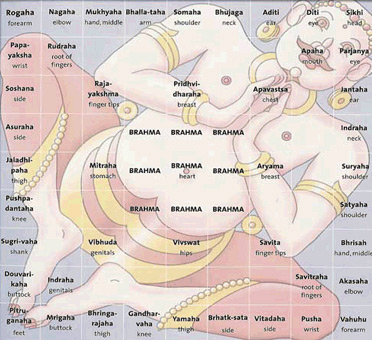
The recent natural calamities (earthquakes, tsunamis and cyclones) in Pakistan, Indonesia, the coastal belts of Sri Lanka and India and earlier in Gujarat and in Orissa have left hundreds of thousands dead and homeless. Many of these people are yet to put their lives and properties together.
Were our ancient masters who laid down the laws of Vastu not aware of the destructive powers of natural calamities? Did they not think of these phenomena when they wrote their texts?
They did think of earthquakes, tsunamis, cyclones and other natural calamities when they gave us information about ways and means of construction. They spoke of soil evaluation before construction began. They believed that a foundation of a building was much more than a combination of bricks, mortar, concrete, steel etc. They felt that laying a foundation was a symbolic homage to Mother Earth by man and every possible care to strengthen it was necessary.
Depth of Foundation
They particularly talked about depth of a foundation (bhumilamba). In fact ancient treatises on Vastu Sastra have customarily advised a foundation that is equal to a man’s stature plus his length of hand. Today’s engineers tell us that six to seven feet of foundation is necessary for a normal height building to be firm and secure. Our masters also highlighted the importance of the base (adhishtana) being as high as the foundation.
They spoke of the importance of pillars and columns in making a building strong. They talked about decreasing heights for each floor of the building. We notice that ancients built multi-storeyed buildings such that the height of each floor slowly reduced as they went up. In fact Brihat Samhita of Varahamihira tells us the each floor should be less than the floor below it by 1/12th its height. They may have deduced that during an earthquake or other natural calamities such a building could sway but not fall.
Earthquakes themselves do not kill people, but badly constructed buildings do. Being aware of this fact our ancients gave importance to every aspect of foundation including the materials used. They spoke of the need to vibe with Nature by using construction materials like bricks (Ishtika), stones (Sila) and wood. The ancient classical texts also spoke of wood as basic material not only for doors, windows, and cabinets but also for structures too. In fact it is commonly known in engineering that wood absorbs shock evenly and a house built out of wood is unlikely to collapse. Wood and steel are said to be ductile and less prone to seismic disturbances.
Importance of spacing out buildings
Our ancients while speaking of buildings have highlighted the Paisacha zone of a mandala. They divide an area into four concentric zones. The inner zone is Brahma, the next is Daiva, the third zone is Manushya and the fourth zone is Paisacha.
They have very clearly specified construction on the Daiva and Manushya zones and totally disapproved of construction on the Paisacha. To apply this to present times, we need to construct the building away from the compound so that it does not touch the neighbour's wall.
Modern Engineering tells us that adjacent buildings should be separated by sufficient distance to prevent hammering each other in case of seismic disturbances!
Structural and Sital Shapes
Another important uncompromising thumb rule of our masters of wisdom was in respect of the shape of a structure. Our ancient writers have invariably recommended square, rectangular, circular and other regular shapes. Irregular shapes have been prohibited. The square (Chaturasra) is the fundamental, essential and perfect form of Indian Architecture. A square presupposes the circle and in fact results from it. Expanding energy shapes the circle from the center and then establishes itself in the shape of a square. In a square, the primary elements of Nature (Pancha Mahabhootas) are also said to be in perfect balance The Chaturasra, because of its perfect shape is considered sacred and superior in Indian Architecture. We find today’s engineering principles telling us that geometric shapes like squares, rectangles and triangles disperse seismic forces equally in all directions and are therefore safe in the case of natural calamities. Irregular shapes result in uneven distribution of forces thereby making buildings prone to collapse!
The recent earthquakes, tsunamis and cyclones saw most modern buildings collapse. Yet these devastating forces of nature could not disturb many temples built hundreds of years ago based on certain principles of construction as rooted in Vedic tradition. Are these not proof of the great scholarship of our ancient masters of architecture? Are these not proof of the fact that they were aware of many of the known and unknown laws of Nature and their relationship to man and his buildings?
Disturbing Energies
Generally Vastu refers to the energies from the North-west and South-east as disturbing energies It is pertinent to note here that the earlier earthquakes of Gujarat and Seattle took place in the northwest of India and America respectively. The earthquake in Indonesia at the fag end of the year 2004 that devastated crores worth of property and killed more than 1,50,000 people spread across 12 nations. The tidal waves generated by the earthquake travelled northwest to the coastal belt of Tamil Nadu, Orissa, Sri Lanka, Andaman and Nicobar and other places and killed thousands of innocent people.
A careful observation reveals that the tsunami tidal waves moved along the North-west-South-east diagonal to hit India and Sri Lanka. The powerful earthquake this month that rocked parts of Pakistan and India and caused enormous damage to lives and property occurred to the northwest of India.
Summing up, the ancient masters of Indian architecture took into account all aspects of celestial and terrestrial nature - cosmological, philosophical, metaphysical, astronomico- astrological, geographical and geological- to make man live in harmony with Nature and Her laws!
Our architects and engineers have just to take what our Vedic seers have handed over to us on a platter and apply it to the modern buildings and layouts so that the residents live in security, safety and happiness.
Kuchipudi Dance
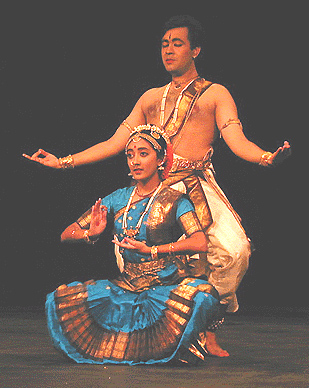
Many wonderful stories exist about the origin of the Bhagavata Mela Natakam of Andhra Pradesh. In the 14th century, the southern parts of India were ruled by a succession of dynasties committed to the propagation of art and literature. The rulers not only gave land and money to gurus and performers, but also paid for the upkeep of several hundred temple dancers, the rajanartakis and devadasis.
Bhagavatars, Bhaagavata Mela Natakam and Kuchipudi
It was under Siddhendra Yogi at the village Kuchelapuram in Divi seema, at the confluence of the river Krishna and the Bay of Bengal that the actual training of the actors was developed to make them into Bhagavatulu, performers of the Bhagavata Mela Natakams. It was here that Siddhendra Yogi first developed a unique and particular style based on the Natya Shastra and Nandikeshwar’s Bharatarnava.
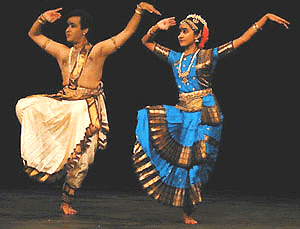
Hasta Bhedas
According to Bharatamava, there are two major varieties of hasta mudras (symbols of the hand), the asamyuta (single) and the samyuta (combined). These are used at different levels of the body, in different directions and in various configurations to mean a variety of things.
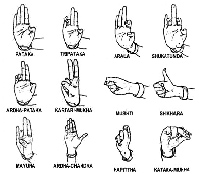
Asamyuta Hastas - Symbols for the single hand:
There are twenty-eight asamyuta mudras classified as:
Pataka, Tripataka, Ardha-pataka, Kartari-Mukha, Mayura, Ardha-chandra, Arala, Shukatundaka, Mushti, Shikhara, Kapittha, Kataka-mukha, Suchi, Chandrakala, Padmakosha, Sarpa-Shirsha, Mriga-shirsha, Simha-mukha, Langula, Sola-padma, Chatura, Bharamara, Hamsasya, Hamsapaksha, Samdamsa, Mukula, Tamrachuda and Trishula
Karana and Angarhara
According to Sarangadeva in the Sangita Ratnakar, a beautiful classical pose, formed by changing the hands and legs in dance, conditioned by the mood or flavour, is known as a karana. Bharata, in the Natya Shastra, merely defines a karana as a combined movement of the feet and the hands which, though momentarily static, is a dynamic series of movements which culminates in a specific pose.
By themselves, the karanas are beautiful aspects of dance, believed to have originated with Shiva-Nataraja’s Tandava. Pandits like Somanathkavi, Abhinavagupta and Sarangadeva suggested their use along with bhava so as to expand their utility into the realm of abhinaya. Over the years, gurus interpreted karanas with expressions in the Bhagavata Mela Natakam style, thereby incorporating these karanas into javalis and padams.
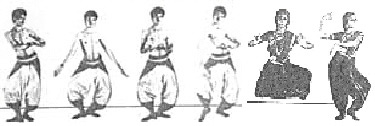
Karana
The hundred and eight karanas as described in the Natya Shastra:
- Pushpaputa: handful of flowers
- Vartita: Inverted
- Valitorukam: Turned thighs or thighs filded in
- Apaviddha: Violent shaking-off
While Shiva performed the Tandava, several karanas were linked together as a garland of dance poses with the help of rechakas. These became the angaharas, garlands of dance poses for lord Hara. Each combination of angahara contains six, seven, eight or nine karanas. There are thirty-two angaharas, according to Bharata.
Later, learned experts in the field of dance created several additional angaharas in their own style. These were in different combinations of karanas and subsequently were different from those of Bharata. Sthirahasta: Lina, Nikuttitam, Urudvrutta, Swastika, Akshipta, Nitamba, Karihasta and Katichinna.
Paryasthaka: Puspaputa, Apavidaha, Vartita, Nikuttitam, Urudvrutta, Nitamba, Karihasta, and Katichinna.
Suchividdha: Vikshipta, Avarta, Nikuttitam, Urudvrutta, Akshipta, Uromandala, Karihasta and Katichinna.
Apaviddha: Apaviddha, Suchividdha, Uromandala and katichinna.
Navarasa
In the context of Kuchipudi dance, rasa is the quality that makes for understanding between the artist and the spectator. It can be translated in a wide sense as 'relish' or 'flavour' but perhaps 'aesthetic experience' gives a clearer idea of the real meaning. Rasa is a concentrated, knowledgeable identification of spectator with the spectacle, where, as Tolstoy put it, 'one man consciously, by means of certain signs, hands on to others feelings he has lived through, and that other people are interested by these feelings and also experience them'.
Rasa in the Indian theory of aesthetics is the tasting of the flavour of a work of art. It is the quintessence of bhava or state of being which is divided again into the sthayibhavas (durable sates) brought forth by vibhavas (causes of emotion or determinants), anubhavas (indications or consequents), and sanchari or vyabhichari bhavas (transient or fleeting states).
The Seven Kinds of Ritual Dance
According to early traditions, there were even kinds of dance that were the beginning of all dances, and which were combinations of karanas, charis, rechakas, etc. These were set in particular talas to particular shabdas. Each, according to Nandikeshwara, originated with the God or Goddess - Shudda Natya with Shiva, Deshini with Parvati, Peruni with Brahma, Prenkhani with Saraswati, Kundali with Vishnu, Dandika and Kalasha with Lakshmi. However, only the first two were accepted as divine by the Bhagavata Mela Natakam gurus and taken into the sampradaya. The rest were considered to have evolved from lokadharmi i.e., from the people themselves.
Music in Kuchipudi Dance
A raga (musical mode) with its unique and individual pattern is the soul of Indian music. Each raga has a special structure of fixed notes. It is the way in which a musician utilises this structural form that makes for the full expression of the different melodic types. Ancient authors gave the essential characteristics of ragas as the utilisation of special notes while avoiding some notes and rendering others with embellishments or graces (alankaras). Interestingly ragas were meant, according to their emotional appeal, to be sung only at certain times a day.
The ragas were also associated with visual images. For instance, the raga Bhairavi, the South Indian Mayamalavagaula is described as " a beautiful sannyasi, his face smeared with white ashes. He wears a white scarf and around his neck is a garland of rubies. From his earrings hang pendants and on his forehead shines the crescent moon. Matted locks crown his head. He has the ekatara, one stringed instrument, in his hand and is seated upon a white bull. He is engaged in meditation on the banks of Ganges river".
Vedic Mathematics: Ancient Indian Knowledge
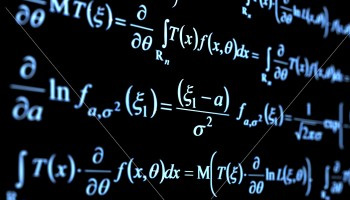
Indian civilization has surprised academicians time and again with simple age old techniques for solving complex problems. Vedic Mathematics, derived from the Ganita Sutra in the Vedas is one such technique.
Vedic Mathematics is the name given to the ancient system of Mathematics which was rediscovered from the Vedas between 1911 and 1918 by Sri Bharati Krsna Tirthaji (1884 - 1960).
In the beginning of the twentieth century, when there was a great interest in various Sanskrit texts in Europe, some scholars ridiculed certain texts which were titled GANITA SUTRA, which means mathematics. They could not decipher any mathematics in the translations and therefore dismissed the texts as rubbish. Bharati Krsna, who himself was a scholar of Sanskrit, Mathematics, History and Philosophy, studied these texts and after lengthy and careful investigation was able to reconstruct the mathematics of the Vedas.
Bharati Krsna wrote sixteen volumes expounding the Vedic system but these were unaccountably lost and when the loss was confirmed in his final years he wrote a single book - Vedic Mathematics. It was published in 1965, five years after his death.
According to his research all of mathematics is based on sixteen Sutras, or word - formulae. For example, ‘Vertically and Crosswise’ is one of these Sutras. These formulae describe the way the mind naturally works and are therefore a great help in directing the student to the appropriate method of solution.
Perhaps the most striking feature of the Vedic system is its coherence. Instead of a hotchpotch of unrelated techniques the whole system is beautifully interrelated and unified. The multiplication method, for example, is easily reversed to allow one-line divisions and the simple squaring method can be reversed to give one-line square roots. And all are very easy to understand. This unifying quality is very satisfying; it makes mathematics easy and enjoyable and encourages innovation.
In the Vedic system difficult problems or huge sums can often be solved immediately by the Vedic method. These striking and beautiful methods are just a part of a complete system of mathematics, which is far more systematic than the modern system. Vedic mathematics manifests the coherent and unified structure of mathematics and the methods are complimentary, direct and easy.
The simplicity of Vedic Mathematics means that calculations can be carried out mentally (though the methods can be written down). There are many advantages in using a flexible, mental system. Pupils can invent their own methods; they are not limited to the one correct method. This leads to more creative, interested and interesting pupils.
Interest in the Vedic system is growing in education where mathematics teachers are looking for something better and finding Vedic system is the answer. Research is being carried out in many areas including the effects of learning Vedic Mathematics on children, developing new, powerful but easy applications of the Vedic Sutras in geometry, calculus, computing etc.
But the real beauty and effectiveness of Vedic Mathematics cannot be fully appreciated without actually practicing the system. One can then see that it is perhaps the most refined and efficient mathematical system possible.
Why do we need to combine Pure and Vedic Mathematics?
Schools all over the world utilize pure mathematics for their curriculum. Therefore an in-depth knowledge of pure mathematics is essential from the examination point of view. Unfortunately the mathematics that is taught is most schools and colleges lack flexibility and therefore become ‘boring’ to the students. On top of that many teachers lack the insight and knowledge required to teach the subject. Fixed methods are also used for all operations thereby making the process of calculation lengthy and tiresome.
The right combination of Vedic and pure mathematics ensures correct understanding, extreme flexibility and an in-depth knowledge of the subject, thereby making calculations extremely rapid and interesting. This combination can be utilized for simple addition and subtraction, and also for more difficult operations like calculus, and algebra. Many of these operations can be done mentally. Therefore this can be used for students of all ages and standards. There are also wonderful methods for checking the sums.
Utilizing this method, the student will become faster and more accurate in all-mathematical procedures.
27, జూన్ 2009, శనివారం
Breath

The nose has a left and a right side; we use both to inhale and exhale.
Actually they are different; you would be able to feel the difference.
The right side represents the sun, left side represents the moon.
During a headache, try to close your right nose and use your left nose to breathe.
In about 5 mins, your headache will go?
If you feel tired, just reverse, close your left nose and breathe through your right nose.
After a while, you will feel your mind is refreshed.
Right side belongs to 'hot', so it gets heated up easily, left side belongs to 'cold'.
Most females breathe with their left noses, so they get "cooled off" faster.
Most of the guys breathe with their right noses, they get worked up. 
Do you notice the moment we wake up, which side breathes faster? Left or right? ?
If left is faster, you will feel tired.
So, close your left nose and use your right nose for breathing, you will get refreshed quickly.
This can be taught to kids, but it is more effective when practiced by adults.
My friend used to have bad headaches and was always visiting the doctor.
There was this period when he suffered headache literally every night, unable to study.
He took painkillers, did not work.
He decided to try out the breathing therapy here: closed his right nose and breathed through his left nose.
In less than a week, his headaches were gone! He continued the exercise for one month.
This alternative natural therapy without medication is something that he has experienced.
So, why not give it a try?
ఘర్మజలం
ఘర్మజలం

- బులుసు-జీ-ప్రకాష్
శ్రీకృష్ణుని వద్దకు కుచేలుడు వెళ్లినపుడు ''ఇక్కడికి నువ్వు వస్తున్నప్పుడు నా మీద భక్తికొద్దీ ఏదో కానుక తెచ్చి ఉంటావు. అది కొంచెమైనాసరే, పదివేలుగా అంగీకరిస్తాను. భక్తి హీనుడై, నీచవర్తనుడైన దుష్టాత్ముడు మేరుపర్వత సమానమైన పదార్థం ఇచ్చినా అది నాకు సమ్మతం కాదు'' అంటాడు కృష్ణ పరమాత్మ. ఈ విషయాన్నే భగవద్గీత నవమాధ్యాయంలో ధ్రువీకరిస్తాడు.
'పత్రం పుష్పం ఫలం తోయం
యోమే భక్త్యా ప్రయచ్ఛతి
త దహం భక్త్యుపహృతం
అశ్నామి ప్రయతాత్మనః'
''శుద్ధాంతరంగులైన వారు భక్తితో, ఆకుని, పువ్వుని, పండుని, నీటిని- వీటిలో ఏ ఒక్కటి సమర్పించినా, నేను తప్పకుండా స్వీకరిస్తాను''
సిక్కు మతాచార్యుడు నానక్ దేవ్ తన శిష్యుల కోరిక మేరకు ఒక గ్రామం వెళతారు. ఆ గ్రామంలో ధనవంతులెక్కువ, బీదవాళ్లు తక్కువ. నానక్ గురుదేవులు ఆ గ్రామంలో అడుగు పెట్టగానే అందరూ తమ ఇంటికి దయచేయండంటే తమ ఇంటికి దయచేయండని స్వాగతం చెబుతారు. ఊరంతా తిరిగితిరిగి నానక్ దేవులు ఒక నిరుపేద ఇంట్లో భోజనం చేస్తారు. ఆ ఊళ్లో అత్యధిక ధనవంతుడు ''ఇదేమి విడ్డూరం స్వామీ! మేమెవ్వరం పిలిచినా రాని తమరు ఒక నిరుపేద ఇంట్లో, అందునా ఒక పూరిగుడిసెలో భోజనం చేస్తారా?'' అని ప్రశ్నిస్తాడు.
''సరే, మీ ఇంటికి వస్తున్నా పద!'' అని ఆ ధనవంతుని ఇంటికి నానక్దేవ్ వెళతారు. ఆ ధనవంతుని ఇంట్లోని కొద్ది ఇసుకను తీసి పిండుతారు. అందులోనుంచి రక్తపు బొట్లు పడతాయి. ''చూశావా? నీ ఆర్జన అక్రమమైనది. అడ్డదార్లు తొక్కి పేదల రక్తాన్ని పిండి సంపాదించినది!'' అంటూ ఆయన బీదవాని ఇంటికి తీసుకెళతారు ఈ ధనికుణ్ని. ఆ బీదవాని ఇంట్లో ఇసుక పిండుతారు. అందులోనుంచి చెమటబొట్లు రాల్తాయి. అంటే ఆ బీదవాడు కష్టపడి చెమటోడ్చి సంపాదించిన ధనం అది! అది చూసి ధనవంతుడు సిగ్గుతో తల దించుకుంటాడు.
'కర్మణ్యేవాధికారస్తే, మా ఫలేషు కదాచన'
అనే శ్రీకృష్ణుని ఆదేశం ప్రకారం చెమటోడ్చి కష్టించి పని చేసే శ్రమజీవులు తమ కష్టఫలాన్ని భగవంతునికి సమర్పిస్తే ఆ 'ధర్మజలానికి, ఘర్మజలానికి ఖరీదు కట్టే షరాబు' ఒకడున్నాడు.
ఆతడే శ్రీకృష్ణపరమాత్మ!
కబళించేముందే కళ్లు తెరవాలి..
కబళించేముందే కళ్లు తెరవాలి..
 వెలది.. పానంబు.. జూదంబు.. అంటూ తిక్కన సప్తవ్యసనాల జాబితాను ఓ పద్యంలో వెల్లడించాడు. స్త్రీ, పానం, జూదం, వేట, వాక్పారుష్యం, దండపారుష్యం, దుర్వ్యయం.... అంటూ వాటిని ఓ రచయిత వచనంలోకి దించారు. మద్యపానంకన్నా ధూమపానం మరీ ప్రమాదకరమైనదని శాస్త్రజ్ఞులు గట్టిగా తేల్చి చెబుతున్నారు. అందువల్ల మనం సప్తవ్యసనాల్లో పానాన్ని- ధూమపానానికి అన్వయించుకోవలసి ఉంది. ప్రాణాంతకమైన ధూమపాన వ్యసనం ప్రజల్లో బహుళవ్యాప్తికి నోచుకోవడం సామాజిక శాస్త్రవేత్తలను తీవ్రంగా కలవరపరుస్తోంది. యువతలో ఈ అలవాటు త్వరగా వ్యాపించడానికి సావాసదోషమే బలమైన కారణమంటున్నారు. సరదాగా మొదలై అలవాటుగా మారి, అది వ్యసనంగా స్థిరపడుతుంది. సురేంద్రనాథ్ బెనర్జీ అంతటివాణ్ని చేస్తానన్న గిరీశం అయ్యవారినుంచి తనకు అబ్బిందల్లా చుట్టకాల్చే అలవాటు ఒక్కటేనని- వెంకటేశం వాపోవడంలో వాస్తవముంది. సిగరెట్లు వెలిగించడమే తప్ప అగరొత్తులు వెలిగించడం రాని తండ్రినుంచి కొడుక్కి ఏం అలవాటు అవుతుందో మనం తేలిగ్గానే ఊహించవచ్చు. తెలుగు పద్యం ఒకటి చెప్పమని కరటకశాస్త్రి అడగ్గానే వెంకటేశం నోట అలవోకగా 'పొగచుట్టకు... సతిమోవికి' పద్యం వెలువడటం సావాసదోషఫలమనే అనుకోవాలి. ''చుట్టకాల్చబట్టే కదా దొరలు అంత గొప్పవాళ్ళయ్యారు! చుట్టకాల్చని ఇంగ్లీషువాణ్ని చూశావూ?'' అని ఊదరగొడుతుంటే వెంకటేశానికి చుట్టకాల్చడంతప్ప, మరి చదువెలా అబ్బుతుంది! చుట్ట పంపిణీ మీదనే స్టీము యంత్రం వగైరాలను ఇంగ్లీషువాడు కనిపెట్టగలిగాడన్నది గిరీశం సిద్ధాంతం. చుట్టకాల్చడానికి, దొరతనానికి ఏదో 'చుట్ట'రికం ఉండే ఉంటుందని మనకవులు కూడా భావించారు. సరదా సరదా సిగరెట్టు.. ఇది దొరలు తాగు బల్ సిగరెట్టు.. అంటూ దాని మహిమను వర్ణించాడో సినీకవి. పొగతాగనివాడు తరవాత జన్మలో ఏమవుతాడో 'బృహన్నారదీయం' చెప్పింది- అని గిరీశం దబాయించాడు. ''...ఈ సిగరెట్టుతో ఆంజనేయుడు లంకాదహనం చేశాడు...'' అని సినీకవి బుకాయించాడు.
వెలది.. పానంబు.. జూదంబు.. అంటూ తిక్కన సప్తవ్యసనాల జాబితాను ఓ పద్యంలో వెల్లడించాడు. స్త్రీ, పానం, జూదం, వేట, వాక్పారుష్యం, దండపారుష్యం, దుర్వ్యయం.... అంటూ వాటిని ఓ రచయిత వచనంలోకి దించారు. మద్యపానంకన్నా ధూమపానం మరీ ప్రమాదకరమైనదని శాస్త్రజ్ఞులు గట్టిగా తేల్చి చెబుతున్నారు. అందువల్ల మనం సప్తవ్యసనాల్లో పానాన్ని- ధూమపానానికి అన్వయించుకోవలసి ఉంది. ప్రాణాంతకమైన ధూమపాన వ్యసనం ప్రజల్లో బహుళవ్యాప్తికి నోచుకోవడం సామాజిక శాస్త్రవేత్తలను తీవ్రంగా కలవరపరుస్తోంది. యువతలో ఈ అలవాటు త్వరగా వ్యాపించడానికి సావాసదోషమే బలమైన కారణమంటున్నారు. సరదాగా మొదలై అలవాటుగా మారి, అది వ్యసనంగా స్థిరపడుతుంది. సురేంద్రనాథ్ బెనర్జీ అంతటివాణ్ని చేస్తానన్న గిరీశం అయ్యవారినుంచి తనకు అబ్బిందల్లా చుట్టకాల్చే అలవాటు ఒక్కటేనని- వెంకటేశం వాపోవడంలో వాస్తవముంది. సిగరెట్లు వెలిగించడమే తప్ప అగరొత్తులు వెలిగించడం రాని తండ్రినుంచి కొడుక్కి ఏం అలవాటు అవుతుందో మనం తేలిగ్గానే ఊహించవచ్చు. తెలుగు పద్యం ఒకటి చెప్పమని కరటకశాస్త్రి అడగ్గానే వెంకటేశం నోట అలవోకగా 'పొగచుట్టకు... సతిమోవికి' పద్యం వెలువడటం సావాసదోషఫలమనే అనుకోవాలి. ''చుట్టకాల్చబట్టే కదా దొరలు అంత గొప్పవాళ్ళయ్యారు! చుట్టకాల్చని ఇంగ్లీషువాణ్ని చూశావూ?'' అని ఊదరగొడుతుంటే వెంకటేశానికి చుట్టకాల్చడంతప్ప, మరి చదువెలా అబ్బుతుంది! చుట్ట పంపిణీ మీదనే స్టీము యంత్రం వగైరాలను ఇంగ్లీషువాడు కనిపెట్టగలిగాడన్నది గిరీశం సిద్ధాంతం. చుట్టకాల్చడానికి, దొరతనానికి ఏదో 'చుట్ట'రికం ఉండే ఉంటుందని మనకవులు కూడా భావించారు. సరదా సరదా సిగరెట్టు.. ఇది దొరలు తాగు బల్ సిగరెట్టు.. అంటూ దాని మహిమను వర్ణించాడో సినీకవి. పొగతాగనివాడు తరవాత జన్మలో ఏమవుతాడో 'బృహన్నారదీయం' చెప్పింది- అని గిరీశం దబాయించాడు. ''...ఈ సిగరెట్టుతో ఆంజనేయుడు లంకాదహనం చేశాడు...'' అని సినీకవి బుకాయించాడు.మొన్ననే క్యూబా అధ్యక్ష పదవిని త్యజించిన ఫిడెల్ క్యాస్ట్రోకి, అమెరికానే వణికించిన సద్దాం హుస్సేన్కీ -క్యూబా చుట్టలే ఒకానొక గంభీరమైన ఇమేజిని తెచ్చాయంటారు. ''స్వర్గంలో కనుక సిగార్పై నిషేధం విధించే పక్షంలో నేనసలు స్వర్గం వైపే పోను'' అన్నాడు మార్క్ట్వెయిన్. ''ఇంత చవగ్గా దొరికే ఆనందం ప్రపంచంలో మరొకటి ఏముంది?'' అని ప్రశ్నించాడు సిగ్మండ్ ఫ్రాయిడ్. ''అందమైన స్త్రీ ఇచ్చే ఆనందంతో పోలిస్తే సిగార్ తక్కువేంకాదు'' అన్నాడు ప్రముఖ రచయిత రుడ్యార్డ్ కిప్లింగ్. మడొన్నా, డెమీమూర్, ఎవావన్నెస్సా, రెబెక్కా... వంటి ప్రపంచ ప్రసిద్ధ సుందరీమణులు సైతం సిగార్స్ను బాగా ఇష్టపడేవారే. ప్రసిద్ధ కథారచయిత చాసో నుంచి బ్రిటన్ మాజీ ప్రధాని చర్చిల్దాకా ప్రముఖులెందరో చుట్టలను ప్రేమించేవారు. నోట్లో చుట్టతో ఫొటోలు దిగేవారు. పొగతాగడం అలవాటైనవారు దాన్ని రకరకాలుగా సమర్థించడం కూడా సహజం. వేడివేడిగా కాఫీతాగాకా, సిగరెట్టు ముట్టించకపోతే కాలకృత్యాలు మొదలుకావని చాలామంది అనుభవం. సిగరెట్టు చేతిలో లేకపోతే, రెండో చేతిలో కలం కదలదని భావించే రచయితలూ ఉన్నారు. అలాంటి కవి ఒకరు తన అలవాటును త్రిమూర్తులకు సైతం అంటగట్టారు. త్రిమూర్తులు పొగతాగడం చూసి నారదమహర్షి ఆశ్చర్యపోయి ''మీరును పొగతాగుదురా! వారిజభవ.. ఆదిదేవ.. వైకుంఠపతీ..'' అని అడిగాడట. దానికి వారు బదులిస్తూ ''ఓరీ నారద.. వినరా.. ఈరేడు జగంబులందున ఇది ముఖ్యమురా!'' అన్నారని ఆయన అచ్చుగుద్ది మరీ చెప్పాడు. ఒకే సిగరెట్టును నలుగురైదుగురు మిత్రులు నిస్సంకోచంగా పీల్చేయడంలో తప్పులేదు, అది ఎంగిలి కాదన్నాడొక కవి. ''పొగక్రోవికి.. సతిమోవికి.. అగణితముగ సూరకవికి.. అమృతమ్మునకున్ తగ ఉచ్ఛిష్టము లేదు..'' పొమ్మన్నాడాయన. ఏ మాటకామాటే చెప్పుకోవాలి- నోట్లో ఎర్రగా వెలుగుతుంటే దర్జాకి కారణమయ్యే చుట్ట, ఆరిపోయి చెవి వెనుక చేరితే మాత్రం వెర్రిబాగులతనానికి ఒక చిహ్నంగా మిగిలిపోతుంది.
ఎంతమంది ఎంతగట్టిగా వాదించినా, పొగతాగడాన్ని డాక్టర్లు ఎంతమాత్రమూ సమర్థించడం లేదు. చుట్ట, బీడీ, సిగరెట్టు... ఏదైనా యమపాశమేనని అధ్యయనాలు స్పష్టంగా వెల్లడిస్తున్నాయి. పొగతాగేవాళ్లలో స్త్రీలైతే దాదాపుగా ఎనిమిదేళ్లు, మగవారు పదేళ్లు ఆయుర్దాయాన్ని కోల్పోతున్నారని తేలింది. 2010 సంవత్సరం వచ్చేసరికి ప్రతిఏటా పదిలక్షల మందిని ధూమపానం ఖాయంగా బలిగొంటుందని స్పష్టమైంది. ప్రపంచ ఆరోగ్యసంస్థ సహకారంతో టొరొంటో విశ్వవిద్యాలయానికి చెందిన ప్రపంచ ఆరోగ్య అధ్యయన కేంద్రం ఈ విషయమై విస్తృతమైన పరిశోధనలు నిర్వహించింది. విషాదకరమైన ఆ ఫలితాలను ప్రకటించిన ప్రొఫెసర్ ప్రభాత్ ఝా మనదేశంలో అవి మరింత దిగ్భ్రాంతిని కలిగించేవిగా వర్ణించారు. రెండేళ్ల తర్వాత భారతదేశంలో సంభవించే అకాలమరణాల్లో సగం సంఖ్యకు కేవలం ధూమపానం కారణమవుతుందని ఝా భావిస్తున్నారు. క్షయ, శ్వాసకోశవ్యాధులు, కేన్సర్తోపాటు పలురకాల గుండెజబ్బులకు సైతం పొగతాగడమే కారణమవుతుందని, ఆ కారణంగా మిగిలిన దేశాలకన్నా, మన దేశంలో మరణాల సంఖ్య అత్యధికమనీ ఆయన విశ్లేషించారు. సకాలంలో దాన్ని నివారించకపోతే తీవ్ర దుష్పరిణామాలు తప్పవని హెచ్చరిస్తున్నారు. ఈ విషయం చాలామందిని ఆందోళనకు గురిచేస్తోంది. 'కబళించేముందే కళ్లు తెరవండి' అనే నినాదంతో ఉద్యమస్ఫూర్తితో ప్రజలు స్వయంగా ఈ ఉపద్రవాన్ని ఎదుర్కొంటే తప్ప- ముంచుకొస్తున్న మృత్యుపాశాన్ని తిప్పికొట్టడం సాధ్యంకాదు. ఎవరో వస్తారని ఏదో చేస్తారని ఆశించడంకన్నా ఎవరికివారే ఈ పెనుముప్పును అర్థం చేసుకుని, వ్యసనాన్ని అలవాటు స్థాయిలోనే అరికట్టే ప్రయత్నం చెయ్యడం మంచిదని సామాజిక శాస్త్రవేత్తలు అభిప్రాయపడుతున్నారు.
మానవత్వం పరిమళించిన వేళ...
మానవత్వం పరిమళించిన వేళ...
 తన దగ్గరున్నదంతా దానంచేసి, నిశ్చింతగా నిలబడ్డాడు రంతిదేవుడు. కొద్దిగా మంచినీరు తప్ప, తినడానికి తిండి కూడా లేని స్థితిలో ఉన్నాడు. ఆ పరిస్థితిలో ఆయన దగ్గరికి ఒక పరమ దీనుడు వచ్చి, చేయిచాచి అర్థించాడు. అప్పుడు రంతిదేవుడు అన్నాడు, ''అన్నము లేదు... కొన్ని మధురాంబువులున్నవి... త్రావుమన్న! రావన్న!... శరీరధారులకు ఆపద వచ్చిన, వారి ఆపదల్ క్రన్నన మాన్పి... వారికి సుఖంబులు సేయుటకన్న నొండు మేలున్నదె!... కష్టంలో ఉన్నవాడిని వెంటనే ఆదుకోవడం కన్నా ఈ లోకంలో గొప్ప మేలు మరొకటి లేదు. ఈ తీయని జలాలు తాగి, ప్రాణాలు నిలబెట్టుకో'' అంటూ మిగిలిన మంచినీళ్ళను కూడా యాచకుడికి ఇచ్చేశాడు. మానవత్వానికి పరమోదాహరణగా భాగవతంలో కీర్తిపొందాడు. మానవుడి అసలు తత్వం- మానవత్వం! మానవత్వాన్ని కోల్పోవడమంటే మనిషి తన సహజత్వాన్ని కోల్పోవడమని అర్థం. కలి ప్రభావం కారణంగా మనిషి స్వభావం మారుతుందని భాగవతం హెచ్చరించింది. స్నేహపూరంబుతో ప్రకాశించి, మించె... మానవులు నిల్పికొన్న సమాజదీపము... అది చెదరి... చింది... పంకిలమయినది... అని రాయప్రోలు భయపడినట్లే జరుగుతోంది. కుల, మత, ప్రాంతీయాది విభేదాలతో కొంతకాలంగా సమాజం మానవత్వాన్ని పూర్తిగా మరచిపోతోంది. 'మానవత్వం పరిమళించే మంచిమనిషికి స్వాగతం...' అంటూ కవులు మంచిమనిషి కోసం అన్వేషించవలసిన దుస్థితి దాపురించింది. ''అశ్రువులందే సుందర హాసమున్నదని తెలిపెను... తొలిప్రొద్దున మంచు బిందువులు రాల్చెడు మల్లెపువ్వు...' అంటూ కన్నీటిని తుడిచి, ఓదార్చే మంచితనపు పరిమళాలను ఈ జాతి ఆశిస్తూ వచ్చింది. ప్రార్థనలు చేసే పెదవులకన్నా సహాయపడే చేతులు మిన్న అంటూ సాయంచేసే చేతులకోసం ఎదురుచూస్తూ వచ్చింది.
తన దగ్గరున్నదంతా దానంచేసి, నిశ్చింతగా నిలబడ్డాడు రంతిదేవుడు. కొద్దిగా మంచినీరు తప్ప, తినడానికి తిండి కూడా లేని స్థితిలో ఉన్నాడు. ఆ పరిస్థితిలో ఆయన దగ్గరికి ఒక పరమ దీనుడు వచ్చి, చేయిచాచి అర్థించాడు. అప్పుడు రంతిదేవుడు అన్నాడు, ''అన్నము లేదు... కొన్ని మధురాంబువులున్నవి... త్రావుమన్న! రావన్న!... శరీరధారులకు ఆపద వచ్చిన, వారి ఆపదల్ క్రన్నన మాన్పి... వారికి సుఖంబులు సేయుటకన్న నొండు మేలున్నదె!... కష్టంలో ఉన్నవాడిని వెంటనే ఆదుకోవడం కన్నా ఈ లోకంలో గొప్ప మేలు మరొకటి లేదు. ఈ తీయని జలాలు తాగి, ప్రాణాలు నిలబెట్టుకో'' అంటూ మిగిలిన మంచినీళ్ళను కూడా యాచకుడికి ఇచ్చేశాడు. మానవత్వానికి పరమోదాహరణగా భాగవతంలో కీర్తిపొందాడు. మానవుడి అసలు తత్వం- మానవత్వం! మానవత్వాన్ని కోల్పోవడమంటే మనిషి తన సహజత్వాన్ని కోల్పోవడమని అర్థం. కలి ప్రభావం కారణంగా మనిషి స్వభావం మారుతుందని భాగవతం హెచ్చరించింది. స్నేహపూరంబుతో ప్రకాశించి, మించె... మానవులు నిల్పికొన్న సమాజదీపము... అది చెదరి... చింది... పంకిలమయినది... అని రాయప్రోలు భయపడినట్లే జరుగుతోంది. కుల, మత, ప్రాంతీయాది విభేదాలతో కొంతకాలంగా సమాజం మానవత్వాన్ని పూర్తిగా మరచిపోతోంది. 'మానవత్వం పరిమళించే మంచిమనిషికి స్వాగతం...' అంటూ కవులు మంచిమనిషి కోసం అన్వేషించవలసిన దుస్థితి దాపురించింది. ''అశ్రువులందే సుందర హాసమున్నదని తెలిపెను... తొలిప్రొద్దున మంచు బిందువులు రాల్చెడు మల్లెపువ్వు...' అంటూ కన్నీటిని తుడిచి, ఓదార్చే మంచితనపు పరిమళాలను ఈ జాతి ఆశిస్తూ వచ్చింది. ప్రార్థనలు చేసే పెదవులకన్నా సహాయపడే చేతులు మిన్న అంటూ సాయంచేసే చేతులకోసం ఎదురుచూస్తూ వచ్చింది.... మతమే మానవ జీవితమ్ము... చివురింపంగా వసంతమ్ము... అంటాడు- మధునాపంతులవారు చిత్రించిన రాజరాజనరేంద్రుడు. మనిషి జీవితంలోకి మతం అనేది వసంతంలా ప్రవేశించాలన్నది సహృదయ భావన. ఉపబృంహణం అంటే విత్తునుంచి మొలకెత్తడం. మతం అనే విత్తనంలోంచి మానవత్వం ఉపబృంహణం కావాలని పెద్దలు ఆశించారు. ఆధ్యాత్మిక ప్రగతికి పునాదిగా నిలిచి వ్యక్తిగతంగానూ, సమాజ పురోగతికి తోడ్పడటం ద్వారా సామాజికంగానూ- మతం దోహదం చేయాలని ఆకాక్షించారు. సూది కలపడానికి పుట్టింది, జతచేయడమే దాని ధర్మం. కత్తెర విడదీయడానికి పుట్టింది, ఒకటిని రెండు చేస్తుంది. మతం విషయం వచ్చేసరికి అది సూదితో పోలికకు సరితూగుతుంది. మతం మనిషిని మనిషిని జతచేయడానికి పుట్టింది. మధ్యలో, కొంతమంది స్వార్థపరుల చేతుల్లో దుర్వినియోగం అయిన సందర్భాలు ఉన్నా- మొత్తమ్మీద మతం ఏదైనా మంచితనాన్నే ప్రబోధించింది. మానవత్వాన్నే ప్రశంసించింది. అలా కానినాడు మతం తన ప్రాధాన్యం కోల్పోతుందని సామాజిక శాస్త్రవేత్తలు ఏనాడో అంచనావేశారు. మతములన్నియు మాసిపోవును... మంచియన్నది నిలిచి వెలుగును... అని ఊహించారు. మఠములోన నున్న మతములన్నియుకోసి... ఘటములోన నున్న ఘనుని తెలిసి... ఘనత నిల్పువాడు ఘనతర యోగిరా... అంటూ స్వయంగా యోగి అయిన వేమన మతాతీతమైన యౌగిక స్థితిని నిర్వచించాడు. ఆధ్యాత్మికత అనేది మతంకన్నా ప్రయోజనకరమైందని పెద్దలు గ్రహించారు. మతాన్నుంచి ఛాందసాన్ని వేరుచేస్తే అది ఆధ్యాత్మికతకు దగ్గరవుతుందని భావించారు. సూర్యుడికేసి నడిస్తే నీడలు వాటంతటవే వెనక్కి మళ్లినట్లు, మతాలు బోధించే మంచివైపు నడిస్తే- మతమౌఢ్యాలు వెనకబడతాయని విశ్లేషించారు. అది సరికొత్త ఆధ్యాత్మిక మార్గమవుతుందని లోకంలో రాబోయే మార్పులను గుర్తించారు. అటువంటి జ్ఞానపథాన్ని మనసులో భావిస్తూ, తద్వారా మానవుడిలో కలిగే పరివర్తనను ఊహిస్తూ, ఆ తరహా మంచిమనుషులతో కూడిన సమాజాన్ని స్వాగతిస్తూ- మన కవులెందరో అభ్యుదయ గీతాలు ఆలపించారు.
ఇటీవలి ఒక సంఘటన వింటే ఆ ఆశలు ఫలించాయనిపిస్తున్నది. మతంకన్నా మానవత్వం చాలా విలువైనదని నిరూపించే ఈ సంఘటన ఒరిస్సా రాష్ట్రంలో జరిగింది. హరేకృష్ణ భాంజా అనే హిందువుకు, మహమ్మద్ సయ్యద్ అనే ముస్లిం సోదరుడికి మూత్రపిండాలు బాగా చెడిపోయాయి. వారి భార్యలు తమ అవయవాలను దానం చెయ్యడానికి ముందుకొచ్చినా, భార్యాభర్తల బ్లడ్ గ్రూపులు కలవకపోవడంతో వైద్యులు నిరాశచెందారు. మంజులాబెన్ కిడ్నీ ఆస్పత్రికి చెందిన దీపక్శంకర్రాయ్ అనే వైద్య నిపుణుడు ఒక విశేషాన్ని గుర్తించారు. హరేకృష్ణ భార్య కిడ్నీ మహమ్మద్ సయ్యద్కీ, సయ్యద్ భార్య మూత్రపిండం హరేకృష్ణకీ మార్పిడి చేయడానికి అనుకూలంగా ఉన్నాయని ఆయన గమనించారు. దీంతో డాక్టర్ దీపక్ రంగంలోకి దిగి ఆ రెండు కుటుంబాలను సమావేశపరచారు. ఒకరికొకరు సాయపడేలా ఒప్పించారు. త్యాగాజ్జగతి పూజ్యంతే పశు పాషాణ పాదపాః... త్యాగం అనే ఒక సుగుణం కారణంగా లోకంలో పశువులు, రాళ్లు, చెట్లు సైతం పూజలందుకుంటాయన్న ప్రాచీనసూక్తి మరోసారి వెలుగులోకి వచ్చింది. ఇద్దరు స్త్రీల త్యాగగుణం, మంచితనం ఇద్దరు పురుషులకు జీవదానం చేశాయి. విభిన్న మతాలకు చెందిన రెండు కుటుంబాల పరస్పర సదవగాహన, మానవతావిలువల పరిరక్షణ సంకల్పం- ఆ రెండు కుటుంబాల్లోనూ సంతోషాన్ని నింపాయి. సంకల్పం మంచిదైతే భగవంతుడు సహకరిస్తాడన్నట్లుగా ఈ మధ్యనే జరిగిన ఆ ఇద్దరి మూత్రపిండ మార్పిడి శస్త్ర చికిత్సలూ విజయవంతమయ్యాయి. కథ సుఖాంతమైంది. మొత్తం ప్రణాళికను దిగ్విజయంగా పూర్తిచేసిన డాక్టర్ దీపక్ శంకర్రాయ్- ఇదంతా దేవుడి దయ, వారి సమస్యలకు సరైన సమయంలో పరిష్కారం లభించిందని ముక్తాయించడం ఈ ఉదంతానికి కొసమెరుపు!
(Enadu, 02:03:2008)
వ్యసనంతో సహగమనం
వ్యసనంతో సహగమనం
 హోరున వర్షం మొదలైంది. పొలాల్లో పనిచేసుకుంటున్నవారంతా తలదాచుకోవడానికి ఒక పూరిగుడిసె దగ్గర చేరారు. లోపల చోటు తక్కువై, కొంతమంది మాత్రమే పట్టారు. కాసేపటికి పరిస్థితి ఏమిటంటే- లోపలివారంతా ఏదోవిధంగా బయటపడాలని ప్రయత్నిస్తున్నారు, బయటవాళ్లంతా ఎలాగోలా లోపలికి దూరాలని తోసుకుంటున్నారు. వ్యసనం అనేది- అదిగో... ఆ గాలివానలో పూరిగుడిసె వంటిది! వ్యసనపరులు వాటినుంచి బయటపడాలని తంటాలు పడుతూ ఉంటారు. కొత్తవాళ్లు వ్యసనాలను రుచిచూడాలని సరదాపడుతుంటారు! వరదనీటిలో ఇద్దరు మిత్రులు కొట్టుకుపోతున్నారు. ఒకతనికి ఏదో కాస్త ఆధారం దొరికింది. దాన్ని గట్టిగా పట్టుకున్నాడు. మైదానంలోకి ప్రవేశించాక ప్రవాహతీవ్రత నెమ్మదించింది. అయినా అతను బయటపడలేదు. 'ఇంకా వదిలిపెట్టవేం?' అని రెండోవాడు హెచ్చరించాడు. 'నేను ఎప్పుడో వదిలేశాను. దురదృష్టవశాత్తూ నేను పట్టుకున్నది మొసలిని. ఇప్పుడు నన్ను అది విడిచిపెట్టడం లేదు' అన్నాడు మిత్రుడు- మరింత దూరంగా కొట్టుకుపోతూ. వ్యసనం ఆ మొసలి వంటిది! ఉదాహరణకు సిగరెట్ కాల్చడాన్నే తీసుకోండి. సరదాకనో, చలికాలంలో వెచ్చదనంకోసమో- మనిషి సిగరెట్ కాలుస్తాడు. ఆ పిదప సిగరెట్టే సిగరెట్ను కాలుస్తుంది. చివరికి సిగరెట్ మనిషినే కాల్చేస్తుంది. ఆ బాపతు ధూమపాన ప్రియులందరి జీవితాలూ దుర్భరంగా గడిచి, విషాదంగా ముగుస్తాయి. అమెరికాలో స్త్రీల సగటు ఆయుర్దాయం 78 ఏళ్లుకాగా, పురుషులది 70 మాత్రమే. ఈ వ్యత్యాసానికి మత్తు పదార్థాలు, ధూమపానమే ముఖ్యకారణాలుగా తేలింది.
హోరున వర్షం మొదలైంది. పొలాల్లో పనిచేసుకుంటున్నవారంతా తలదాచుకోవడానికి ఒక పూరిగుడిసె దగ్గర చేరారు. లోపల చోటు తక్కువై, కొంతమంది మాత్రమే పట్టారు. కాసేపటికి పరిస్థితి ఏమిటంటే- లోపలివారంతా ఏదోవిధంగా బయటపడాలని ప్రయత్నిస్తున్నారు, బయటవాళ్లంతా ఎలాగోలా లోపలికి దూరాలని తోసుకుంటున్నారు. వ్యసనం అనేది- అదిగో... ఆ గాలివానలో పూరిగుడిసె వంటిది! వ్యసనపరులు వాటినుంచి బయటపడాలని తంటాలు పడుతూ ఉంటారు. కొత్తవాళ్లు వ్యసనాలను రుచిచూడాలని సరదాపడుతుంటారు! వరదనీటిలో ఇద్దరు మిత్రులు కొట్టుకుపోతున్నారు. ఒకతనికి ఏదో కాస్త ఆధారం దొరికింది. దాన్ని గట్టిగా పట్టుకున్నాడు. మైదానంలోకి ప్రవేశించాక ప్రవాహతీవ్రత నెమ్మదించింది. అయినా అతను బయటపడలేదు. 'ఇంకా వదిలిపెట్టవేం?' అని రెండోవాడు హెచ్చరించాడు. 'నేను ఎప్పుడో వదిలేశాను. దురదృష్టవశాత్తూ నేను పట్టుకున్నది మొసలిని. ఇప్పుడు నన్ను అది విడిచిపెట్టడం లేదు' అన్నాడు మిత్రుడు- మరింత దూరంగా కొట్టుకుపోతూ. వ్యసనం ఆ మొసలి వంటిది! ఉదాహరణకు సిగరెట్ కాల్చడాన్నే తీసుకోండి. సరదాకనో, చలికాలంలో వెచ్చదనంకోసమో- మనిషి సిగరెట్ కాలుస్తాడు. ఆ పిదప సిగరెట్టే సిగరెట్ను కాలుస్తుంది. చివరికి సిగరెట్ మనిషినే కాల్చేస్తుంది. ఆ బాపతు ధూమపాన ప్రియులందరి జీవితాలూ దుర్భరంగా గడిచి, విషాదంగా ముగుస్తాయి. అమెరికాలో స్త్రీల సగటు ఆయుర్దాయం 78 ఏళ్లుకాగా, పురుషులది 70 మాత్రమే. ఈ వ్యత్యాసానికి మత్తు పదార్థాలు, ధూమపానమే ముఖ్యకారణాలుగా తేలింది.పొద్దున్నే ఆరుబయట చల్లని వాతావరణంలో కూర్చుని వేడికాఫీ తాగడం చాలామందికి అలవాటు. ఆ అలవాటువల్ల మనిషికి సంతృప్తి లభిస్తుంది. అలా సంతృప్తి లభించేంతకాలం అది కేవలం అలవాటేనని చెప్పుకోవాలి. ఒకవేళ కాఫీ దొరక్కపోతే, కాలకృత్యాలు మొదలు కాని స్థితి వస్తే మాత్రం- అది వ్యసనంగా ముదిరందని గ్రహించాలి. యువకులు తమలోని ఆత్మన్యూనతా భావాన్ని, లేదా అభద్రతాభావాన్ని పోగొట్టుకోవడంకోసం వ్యసనాలకు లోబడతారని మనస్తత్వవేత్తలు చెబుతున్నారు. 'ఇంతవరకూ సిగరెట్ ముట్టించలేదా! బీరు రుచి చూడలేదా!' అని స్నేహితులు వెక్కిరిస్తారని, వెర్రివెంగళప్పగా జమకడతారన్న భావనతో కొందరు కుర్రవాళ్లు వ్యసనాలకు అలవడతారు. ఎప్పుడు కావాలనుకుంటే అప్పుడు మానేయగలమనీ అనుకుంటారు. 'నేనంత తేలిగ్గా లొంగను... మానేయమంటావా చెప్పు' అని మిత్రులతో పంతాలకు పోయి, కొన్నాళ్లు నిజంగానే మానేస్తారు కూడా! చాలామందిలో ఆ దృఢచిత్తం త్వరలోనే నీరుగారిపోతుంది. మళ్లీ వ్యసనం మొదలవుతుంది. 'సిగరెట్లు మానేయడం చాలా తేలిక... నేను చాలాసార్లు మానేశాను తెలుసా' అని చమత్కారాలకు పోతారు. లేదా, సిగరెట్లకేసి ఆరాధనగా చూస్తూ 'భయంకరమైన నా ఒంటరి జీవితంలో బాసటగా నిలిచింది ఇదే బ్రదర్' అని బరువుగా నిట్టూరుస్తూ ఆత్మవంచనకు పాల్పడతారు. 'ప్రపంచవ్యాప్తంగా ప్రజలు ఈ పొగతాగడంపట్ల ఎందుకింత మక్కువ చూపిస్తారో నాకైతే అర్థంకాదు. రైళ్లలో పొగతాగేవారివల్ల మిగిలినవారికి శ్వాసపీల్చడమూ కష్టతరమవడం నాకు తెలుసు' అని గాంధీజీ అనేవారట. అదివిని ఒకాయన 'బీడీ సిగరెట్ వంటివాటిని ఘాటుగా విమర్శిస్తూ, వాటిని నిషేధించాలని ఉద్యమం మీరు ఎందుకు చేపట్టరాదు?' అని అడిగారు. 'ఆ పని చేస్తే నన్ను 'మహాత్మ' అనడం మానేస్తారు... ఆ ధూమపాన సాధనాలు నాకంటే చాలా గొప్పవి... నిజం!' అన్నారు గాంధీజీ.
గాంధీగారికి వచ్చినట్లే- సిగరెట్లు ఎందుకు కాలుస్తారన్న సందేహం ఒక ఇల్లాలికీ వచ్చింది. మెల్లగా భర్త దగ్గరచేరి 'అసలు నాకు తెలియక అడుగుతా, అంత ఇదిగా కాలుస్తారే... ఆ సిగరెట్లో ఏముందీ?' అని అడిగింది. వెంటనే 'పొగాకు' అనేసి లేచి చక్కా పోయాడా పతిదేవుడు! తరవాత ఏం అడగాలో తెలియక నిలబడిపోయిందావిడ. 'భర్తను అలా వదిలేస్తే మీకే పెద్ద ప్రమాదం ముంచుకొస్తుంది తెలుసుకోండి' అంటున్నారు పరిశోధకులు. 'ఇంట్లో పొగతాగే భర్త ఉంటే భార్యకు పక్షవాతం ముప్పు పొంచి ఉన్నట్లే' అని హెచ్చరిస్తున్నారు డాక్టర్ మరియా గ్లెయిమోర్. డాక్టర్ మరియా నేతృత్వంలోని 'హార్వర్డ్ స్కూల్ ఆఫ్ పబ్లిక్ హెల్త్' బృందం- సుమారు పదహారువేల మందిని పరిశీలించిన తరవాత ఈ చేదునిజాన్ని నిర్ధారించింది. 'వెలుగుతున్న సిగరెట్కు రెండో చివర ఒక మూర్ఖుడు ఉంటాడు' అన్నాడొక ఆంగ్ల రచయిత. 'మూర్ఖుడు అవునో, కాదో గానీ తనకీ, తన ఇంట్లో వారికే కాదు, బయట ఎందరికో చాలా ప్రమాదకారి మాత్రం అవును' అని డాక్టర్ మరియా అధ్యయనం స్పష్టం చేస్తోంది. వ్యక్తిగతంగా ఆ మనిషిలో తలెత్తే తీవ్ర ఆరోగ్య సమస్యలు, భార్యకు పొంచిఉన్న పక్షవాతం ముప్పూ కాక, పరోక్షంగా ఒకరు పీల్చి విడిచిన పొగద్వారా గాల్లోకి వ్యాపించిన క్యాన్సర కారక విషపదార్థాలు ఎంతోమంది ఆరోగ్యానికి చాలా హానికరంగా పరిణమిస్తాయని అమెరికా సర్జన్ జనరల్ నివేదిక సైతం తేల్చిచెప్పింది. పొగ రహిత వాతావరణంలో జీవించే భాగ్యవంతులకన్నా ధూమపానం అలముకున్న వాతావరణంలో కాలంగడిపే అభాగ్యులకు వూపిరితిత్తుల క్యాన్సర్, శ్వాసకోశ రుగ్మతలు, గుండెజబ్బులు రెండురెట్లు ఎక్కువగా సంక్రమిస్తాయని అధ్యయనాలు వెల్లడించాయి. అందుకే 'మీరు మీ భార్యను నిజంగా ప్రేమిస్తున్నారా, అయితే ధూమపానం జోలికి పోనేవద్దు' అని వారంతా గట్టిగా హెచ్చరిస్తున్నారు. 'సొంత వ్యసనం అంతమైతే, పొరుగువాడికి మేలు కలుగును' అని బోధిస్తున్నారు.
(ఈనాడు, సంపాదకీయం, 24:08:2008)